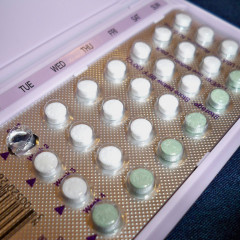
This image of an empty waiting room is perhaps a fitting metaphor for America’s plummeting abortion rate. – Image courtesy of Julep67 (http://bit.ly/1h6YD9G)
In a time when bad news saturates headlines, pro-lifers have reason to rejoice: America’s abortion rate has plummeted in all 50 states to its lowest point since the Supreme Court’s Roe v. Wade decision legalized it in 1973.
According to a paper published by the Guttmacher Institute, there was a 13 percent drop in national abortion rates between 2008 and 2011.
In response, both conservative and liberal activists are rushing to explain why abortions have dropped, predictably attributing the trend to their respective legislative goals. In many cases, the data is conflicting and can be cherry-picked to support one’s presuppositions or hopes. Anyone (including me) who speculates on what is driving this trend assumes the risk of allowing personal bias to influence their explanations.
But as I have surveyed arguments and data coming from both sides, here are three reasons I believe the abortion rate has plummeted:

A 3D ultrasound image depicts an infant’s face. – Image courtesy of Ianiv & Arieanna (http://bit.ly/1fdVxDw)
Scientific Advances: Technology is a double-edged sword when it comes to abortion. On the one hand, drug companies have developed abortifacients that can induce an abortion while saving a woman the trouble and trauma of an invasive procedure. But technological advances have also magnified the ethical questions surrounding pregnancy termination. For example, EEGs have demonstrated that there is human consciousness in the womb early on. Ultrasound advances have made it possible to capture 3D images depicting an unborn child sucking his or her thumb with startlingly detailed facial features. (Though the data is mixed, according to one study, 78 percent of women who were undecided about whether to terminate their pregnancy chose to carry their child to term after being shown an ultrasound.)
Thanks to science, fewer women today look down at their growing bellies and think “ball of tissue” or “clump of cells” as they may have in decades past.

A crowd gathers for the 2014 Right-to-Life March in Washington, DC – Image courtesy of beechwood Photography (http://bit.ly/1e7JykZ)
Effectiveness of the Right-to-Life Movement: The pro-life movement has become a powerful force in American culture shaping the national conversation and influencing public opinion. According to Gallup, most Americans are now pro-life and the number identifying as pro-choice has reached record lows. Meanwhile, Planned Parenthood and Center for Reproductive Rights have failed to beat back abortion regulations through legal means. As Michael New, research associate for the Reproductive Research Audit told “Catholic News Agency,” numerous national studies on attitudes toward abortion show indicate that right-to-life “efforts to change the hearts and minds of Americans may be making a difference.”

According to the CDC, virtually all sexually active women in the U.S. have used some form of contraception. – Image courtesy of Starbooze (http://bit.ly/1fzwc1Q)
Increased Use of Contraception: According to Rachel Jones, lead author of the Guttmacher paper, improvements in contraceptive use were mainly responsible for the abortion decline, which “coincided with a steep national drop in overall pregnancy and birth rates.” Use of long-acting contraceptive methods nearly tripled during the Guttmacher study period.
We might assume Jones’ conclusions to be biased, given that she draws a paycheck from a flagship pro-choice think-tank. But numerous other studies, including a massive 2012 study of more than 9,000 women by St. Louis’s Washington University, have arrived at similar conclusions. The study’s authors estimate that expanding access to free birth control could have a dramatic effect on abortion rates, “preventing as many as 41–71% of abortions performed annually in the United States.”
As a pro-life Christian, I’m opposed to the use of any abortion-inducing drugs or devices. Those are not, in my book, contraception. But the vast majority of contraceptive methods utilized by Americans are helpful and ethical ways of preventing unintended pregnancies and abortions.
Many other factors may also be contributing to rate falling. Many states, for example, have passed stiff abortion regulations in recent years. During last year alone, 22 states adopted 70 different restrictions. Thirty-nine states now require parental notification or consent before a minor can have an abortion. The data on whether these restrictions have significantly influenced the abortion rate is unclear, but many should still be supported on moral, if not pragmatic, grounds.
None of the factors driving this trend seem to be losing steam. Science continues to march forward at warp speed, the pro-life movement remains heavily funded and supported, and the availability and acceptability of contraception will likely expand. So I predict the abortion rate will continue to drop in the United States.
Pro-life Americans have reason to celebrate, and it seems the party is just getting started.





